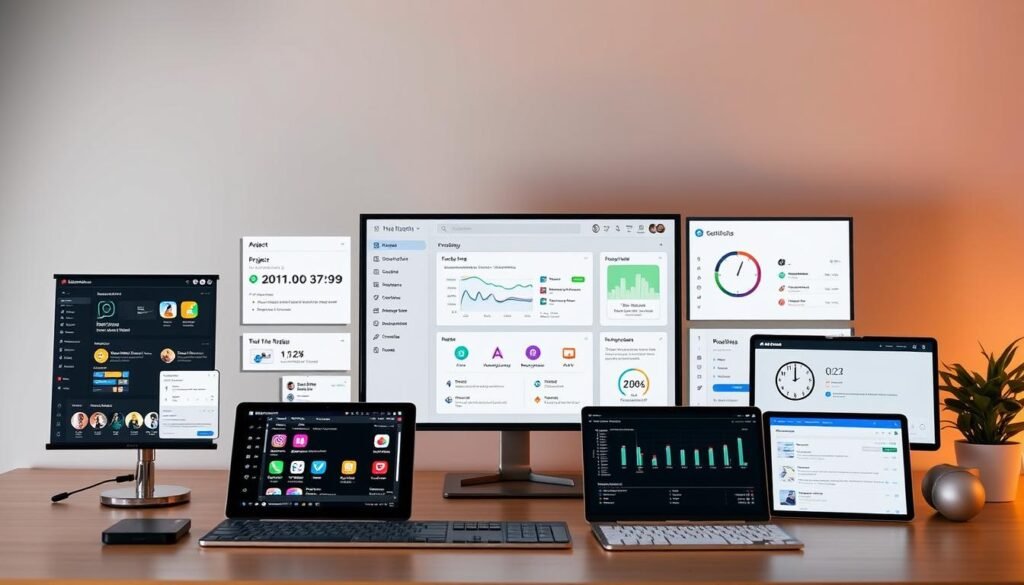Remote Work Essentials: Optimize Your Business and Productivity
A staggering 98% of workers want to work remotely at least some of the time, says Buffer’s 2023 State of Remote Work report. This shows a big change in how we view work and productivity today.
The move to remote work was faster than expected. Companies worldwide had to switch to remote work almost overnight. Many businesses found they could work better and save money.
Working remotely has taught us about flexibility and efficiency. It saves time and money. We’ve learned that you don’t need to be in an office to be productive.
Work-life balance is now key for keeping good employees. Remote work lets people work when they’re most productive. This makes for a better work environment.
Key Takeaways
- Remote work adoption has skyrocketed with 98% of workers preferring flexible options
- Companies report significant cost savings through reduced office space requirements
- Employee productivity often increases when working from a distributed workplace
- Work-life balance improvements lead to higher job satisfaction and retention rates
- Technology advances have made seamless remote collaboration possible across all industries
- Business operations can maintain or exceed efficiency levels in remote settings
The Evolution of Remote Work: How We Transformed Our Business Landscape
The way we work has changed forever. What started as an emergency response has become our strategic advantage. The pandemic transformation pushed us into a new era of telecommuting that we never thought possible just a few years ago.
From Pandemic Necessity to Business Strategy
Before 2020, we viewed remote work with skepticism. Leaders worried about productivity drops and team disconnection. The sudden shift to virtual collaboration proved us wrong. We discovered that employees with autonomy actually deliver better results. Our teams became more focused and efficient working from home.
Business continuity during crisis taught us valuable lessons. We learned to trust our employees and measure output instead of hours. What began as survival turned into competitive advantage. Companies that embraced this change now attract top talent from anywhere.
Technology Advancements That Made Remote Work Viable
Cloud computing revolutionized our ability to work from anywhere. Tools like Microsoft Teams, Slack, and Zoom made virtual collaboration seamless. We can now share files instantly, conduct video meetings, and manage projects in real-time. These platforms ensure business continuity regardless of location.
Statistics That Prove Remote Work Is Here to Stay
The numbers tell a compelling story about our pandemic transformation:
| Metric | 2021 | 2024 |
|---|---|---|
| Companies offerring hybrid work | 42% | 81% |
| Employees preferring remote options | 65% | 87% |
| Productivity increase reported | 58% | 73% |
Forbes research confirms that 87% of workers believe telecommuting improves their work-life balance. AT&T’s expansion of hybrid models reflects this broader trend across industries.
Understanding Remote Work, Business, and Productivity

Remote work has become a key part of business strategy, showing real results. Giving teams control over their work environment boosts growth and happiness. This change brings benefits that go beyond just being convenient.
The Direct Link Between Remote Work and Enhanced Productivity
Research shows remote workers finish tasks 13% faster than those in offices. Employee autonomy is key to this boost. Flexible schedules let team members work best when they can, leading to more productivity.
Remote workers save about 70 minutes a day from not commuting. They often use this time for focused work or learning.
Cost Savings for Businesses and Employees
Remote work saves money for both sides. Here are the savings:
- Companies save $11,000 per remote employee each year on office costs
- Workers save $4,000 yearly from less commuting and eating out
- Companies use 30-50% less space
Work-Life Balance as a Competitive Advantage
Top talent wants flexible schedules as a basic benefit. We draw in skilled workers with remote options that value their personal time. The right tools help keep work and home life separate.
Companies that offer remote work see 25% less turnover. This shows that flexibility keeps employees happy and loyal.
Essential Virtual Collaboration Tools for Distributed Teams
The right tools can make or break a distributed team’s success. When team members work from different places, good video conferencing and messaging tools are key. They’re as vital as a stable internet connection.
Our experience shows that communication is everything in remote management. Slack helps us stay in touch with instant messaging. It keeps conversations tidy in channels. For deeper talks, we use Zoom or Microsoft Teams for video chats.
Managing projects with distributed teams needs special tools. We use these key platforms:
- Asana tracks our project timelines and assigns clear responsibilities
- Google Workspace enables real-time document editing and sharing
- Miro provides virtual whiteboards for brainstorming sessions
- Notion centralizes our knowledge base and team documentation
Cloud-based tools have changed remote management. Dropbox or OneDrive keeps everyone on the same page with the latest files. No more worries about lost attachments or version control. Video conferencing now offers screen sharing, recording, and backgrounds to make meetings better.
Investing in quality tools boosts productivity and team bonds. Our distributed teams feel more connected and aligned with a standard tech stack.
Creating Your Optimal Home Office Setup

Creating a great home office setup is more than just a laptop on your kitchen table. The right workspace design boosts productivity and well-being. Choosing the right remote equipment is key to thriving while working from home.
Ergonomic Essentials for Long-Term Health
Poor ergonomics costs American businesses $54 billion a year in workers’ compensation. Here are the must-haves for your home office:
- Adjustable standing desks from brands like FlexiSpot or Uplift Desk
- Herman Miller Aeron or Steelcase Leap chairs with lumbar support
- Monitor arms positioning screens at eye level
- Ergonomic keyboards and vertical mice from Logitech or Microsoft
Tech Reviews: Must-Have Equipment for Remote Workers
Our tech reviews show that top-notch remote equipment makes a big difference. The Dell UltraSharp U2723DE monitor makes video calls clear. The Blue Yeti microphone ensures top audio quality. For smooth connectivity, we suggest the Netgear Nighthawk WiFi 6 router.
“Your workspace is your personal productivity engine. Design it intentionally.” – Cal Newport, Deep Work author
Designing a Productive Workspace Environment
Good workspace design includes natural light, plants, and areas for focused work. Noise-canceling headphones from Sony or Bose help in shared spaces. Blue tones boost productivity, while green reduces eye strain from screens.
Mastering Remote Management and Team Communication
Successful remote work needs strong virtual leadership and clear team collaboration. Managing teams from afar requires special strategies. These strategies replace spontaneous office chats with planned communication.
Our experience shows that teams do well when managers focus on connection and clarity. This is true in every virtual meeting.
Tips for Managing Distributed Teams Effectively
We use these key tips for remote team management and communication. They help keep our teams engaged and productive:
- Schedule regular one-on-one video calls to discuss projects and personal well-being
- Set clear expectations for deliverables and response times
- Create structured onboarding processes with documented procedures
- Empower team members with decision-making authority
- Celebrate achievements publicly through team channels
Overcoming Communication Barriers in Virtual Settings
Virtual settings lack the casual chats that build relationships. We create special chances for connection. Daily stand-ups on Slack or Microsoft Teams keep everyone on the same page.
Weekly virtual coffee breaks let for informal talks. We use video calls for detailed discussions. This way, we catch nonverbal cues that text messages miss.
Building Trust Without Physical Presence
Trust is key for effective team collaboration in remote settings. We build trust by giving employees control over their schedules and work methods. Actions speak louder than policies – we focus on results, not just hours worked.
Regular check-ins about mental health and workload show we care. Open communication about company goals and challenges makes everyone feel part of the team.
Leveraging Cloud Computing for Seamless Operations

Cloud computing has changed how our remote teams work every day. Moving to cloud storage has removed old barriers to productivity. Now, teams can access files, work on projects, and keep workflows going from anywhere with internet.
Google Drive is our main place for teamwork. Here, team members share documents and work together in real time. No more version control problems from the old email days. Our developers use GitHub for code, tracking changes and working together across different time zones.
Switching to remote work made infrastructure optimization key. We upgraded our bandwidth and picked the best cloud storage for each task. The right infrastructure is key for smooth operations, not constant tech headaches.
| Cloud Service | Primary Use | Monthly Cost | Storage Capacity |
|---|---|---|---|
| Google Drive Business | Document collaboration | $12 per user | Unlimited |
| Dropbox Business | File backup | $15 per user | 5TB minimum |
| Microsoft OneDrive | Office integration | $10 per user | 1TB per user |
| AWS S3 | Data archiving | $0.023 per GB | Unlimited |
Cloud computing means we have one place for all important documents. Version control is automatic, ending the confusion of multiple versions in emails.
Time Management Frameworks for Maximum Productivity
Remote work needs strong self-discipline and good time management. We’ve found that having a plan for our day boosts our work. It helps us avoid burnout and makes our work hours count.
Implementing the Pomodoro Technique in Remote Work
The Pomodoro method divides our day into 25-minute work sessions and 5-minute breaks. We use a timer, ignore distractions, and focus on one task. After four sessions, we take a 15-30 minute break to rest.
This method is great for remote teams because it separates work from rest. We use apps like Forest or Be Focused Pro to keep track and stay accountable with our team.
Getting Things Done (GTD) System for Digital Nomads
David Allen’s Getting Things Done helps us manage our tasks. We have five lists: inbox, next actions, waiting for, projects, and someday/maybe. Every morning, we quickly review to plan our day.
“Your mind is for having ideas, not holding them.” – David Allen
Apps like Notion and Todoist help us follow GTD for remote work. We sort tasks by context (@computer, @calls, @errands) to group similar tasks. This reduces switching between tasks.
Creating Flexible Schedules That Work
Being productive means planning our day around when we’re most energetic. We use time management to respect our natural rhythms and team needs. Some of us are morning people, others after lunch. We celebrate our differences to work better together.
Security Risk Mitigation in Telecommuting Environments
Remote work changes how we protect our business assets. When employees work from home or coffee shops, we face new cybersecurity challenges. We use a mix of security layers to keep data safe and work efficiently.
Protecting Company Data Outside the Office
We set up strict security rules to keep company data safe outside the office. Our team uses encrypted services like Dropbox Business and Google Workspace. These services protect data both in transit and at rest.
We also require two-factor authentication on all accounts. Regular security audits help us find and fix vulnerabilities.
Cybersecurity Measures Every Remote Worker Needs
Our remote workers follow key cybersecurity steps. We teach them to spot phishing and create strong passwords. They also get updated antivirus software and learn to spot suspicious network activity.
| Security Measure | Implementation Cost | Protection Level |
|---|---|---|
| Password Manager | $3-8/month | High |
| Antivirus Software | $30-60/year | Medium |
| Firewall Configuration | Free | Medium |
| Regular Software Updates | Free | High |
VPNs, Encryption, and Secure Access Protocols
We make VPNs mandatory for all remote connections to our servers. Services like NordLayer and ExpressVPN encrypt data. This keeps it safe from being intercepted.
Our secure access rules include role-based permissions. We also regularly review who has access to sensitive systems. This ensures only the right people can get to it.
Productivity Software and Apps: Our Comprehensives Review

We tested many productivity tools for remote teams. We looked for apps that help with workflow and track performance well. After months of testing, we found top tools that change how teams work.
Tracking performance is key for remote work success. Insightful is a standout for this. It watches how people work and trends in the workforce. It also assigns tasks and tracks progress in real-time.
This data shows us where time goes and what works. It helps us understand our work better.
| Software Category | Top Choice | Key Features | Monthly Cost |
|---|---|---|---|
| Employee Monitoring | Insightful | Activity tracking, productivity analysis | $8 per user |
| Workflow Automation | Zapier | 5000+ app integrations | $19.99 |
| Time Management | RescueTime | Automatic time logging | $12 |
| Project Tracking | ClickUp | Task dependencies, Gantt charts | $9 per user |
Automation changed our work life. Zapier connects apps, cutting out boring tasks. This lets our team focus on creative and strategic work. The right tools save us about 10 hours a week per employee.
Analytics in these tools show us where we can improve. They tell us which processes need work and where we’re doing well. We use this info to make better decisions about how to use our resources and training.
Digital Marketing and SEO Strategies for Remote Businesses
Remote businesses face unique challenges in building their digital marketing and seo foundation. Without a physical storefront or traditional networking opportunities, we must rely on smart online strategies to connect with customers and grow our brand. The good news is that remote companies have distinct advantages in the digital space—we’re already comfortable with online tools and can adapt quickly to new platforms.
Latest Trends in SEO for Distributed Companies
The latest trends in seo show that search engines now favor businesses that demonstrate expertise across multiple locations. We’ve seen Google’s algorithm updates prioritize local search results while recognizing distributed teams as legitimate business entities. Voice search optimization has become essential, with 58% of consumers using voice assistants to find local businesses in 2024.
Core Web Vitals remain critical for ranking. Page speed, mobile responsiveness, and user experience signals matter more than ever. We focus on creating content that answers specific questions our audience asks, using natural language that matches conversational search queries.
Social Media Marketing from Anywhere
Social media marketing gives remote businesses the power to build communities without geographical limits. We schedule posts using Buffer or Hootsuite, engage with followers across time zones, and create content that resonates globally. Instagram Reels and TikTok videos perform exceptionally well for remote brands, generating 67% more engagement than static posts.
Content Strategy That Drives Online Presence
Our content strategy focuses on solving real problems for our audience. We publish blog posts, create video tutorials, and share case studies that showcase our expertise. Building a strong online presence requires consistency—we maintain a regular publishing schedule and repurpose content across multiple channels to maximize reach.
The Digital Nomad Lifestyle: Working and Traveling Successfully
Digital nomads are a growing group of professionals who mix work with travel. This lifestyle gives them freedom but needs careful planning and the right tools. They must be good at both working well and enjoying adventures.
Guides to Balancing Work and Travel
Being a digital nomad means finding a balance between work and play. We set work hours that match our clients’ time zones. Then, we have afternoons for exploring.
- Setting clear boundaries between work time and travel time
- Choosing accommodations with reliable Wi-Fi and workspaces
- Planning travel days around lighter workloads
- Building buffer time for unexpected delays or connectivity issues
Remote work and digital nomadism do well with routines. We wake up at the same time, work in the morning, and explore during breaks. This way, we keep clients happy and see new places.
Essential Tools for Location-Independent Professionals
Location independence needs the right tech and services. We use cloud storage like Google Drive and Dropbox for easy file access. Slack helps us stay in touch, no matter where we are. Notion keeps our projects organized, wherever we work.
For digital nomads, banking is key. We use Wise for international money transfers and Charles Schwab for free ATM withdrawals worldwide. These tools make managing money easier while traveling.
Implementing Business Process Optimization for Remote Teams
Business process optimization has changed how our remote teams work every day. We look at each step of our workflows and cut out what’s not needed. This makes our work flow better and helps us manage teams no matter where they are.
We started focusing on workflow efficiency when we saw how much time was wasted on the same tasks. We made a plan to standardize our processes. We wrote down each step, found where things got slow, and made sure everyone could talk easily. Now, our team’s work is better than ever.
Real companies have seen big wins from optimizing their work. Microsoft got 40% more done with better remote work rules. Spotify cut their project time by 35% by making their workflow more efficient.
| Optimization Area | Before Implementation | After Implementation | Improvement |
|---|---|---|---|
| Task Completion Time | 8 hours average | 5 hours average | 37.5% faster |
| Communication Response | 4 hours delay | 1 hour delay | 75% improvement |
| Document Processing | 3 days cycle | Same day completion | 300% efficiency gain |
| Meeting Duration | 90 minutes average | 30 minutes average | 66% reduction |
Standardizing our processes makes things more predictable and helps everyone. We set clear rules, use the same templates, and keep quality high. Now, our remote work runs smoothly because everyone knows what to do.
Collecting and Analyzing Remote Workforce Data
To understand our remote team’s performance, we collect and analyze data. We use workforce analytics to find out where our teams do well and where they need help. This helps us make better decisions to improve productivity and happiness.
Using Google Forms and SurveyMonkey for Employee Feedback
We use Google Forms for quick surveys to get feedback from our remote team. SurveyMonkey helps us with advanced templates to measure engagement and challenges. We ask about productivity, technology, and how they like to work together.
Data Visualization with Tableau and Excel
Survey responses turn into useful insights with data visualization tools. Excel helps us find trends in feedback, and Tableau makes dashboards for planning. We track important metrics like response rates and satisfaction across departments.
| Analytics Tool | Primary Use | Key Features |
|---|---|---|
| Google Forms | Quick surveys | Free, easy sharing, automatic response collection |
| SurveyMonkey | Detailed feedback | Professional templates, branching logic, result analysis |
| Excel | Data analysis | Pivot tables, charts, trend identification |
| Tableau | Visual reporting | Interactive dashboards, real-time updates, data connections |
Making Data-Driven Decisions for Improvement
Our analytics show us where we need to focus. When we saw communication issues, we changed meeting times. Feedback about feeling alone led to virtual coffee breaks. Every quarter, we look at our data to improve our remote work setup based on what our team really needs.
Developing Action Plans for Continuous Improvement
Remote teams need clear ways to track goals and measure success. The right project management tools can turn ideas into plans that work. It’s important to pick tools that fit your team’s way of working and talking.
Project Management with Trello, Asana, and Monday.com
We use visual boards in Trello to organize our remote projects. Each card is a task or milestone. The drag-and-drop feature makes moving projects easy.
Asana helps us break down big projects into smaller tasks. It assigns tasks to team members and sets deadlines. Monday.com lets us customize workflows to fit our needs.
Creating Implementation Roadmaps
We start planning by setting priorities and breaking them into steps. We make detailed plans in shared documents. This way, everyone knows their part.
We use timelines to spot problems early. Our roadmaps include:
- Clear goals with measurable results
- Resources for each step
- Plans for risks
- Regular check-ins
Tracking Progress and Adjusting Strategies
We check our project metrics every week. We adjust our plans based on what we learn. Trello shows who’s doing what, and Asana gives detailed reports.
Monday.com’s dashboards let us see all our projects at once. This feedback helps us stay quick and flexible.
Success Stories: How We Optimized Our Remote Operations
Our journey to operational excellence started with a need to change our old ways of working. We moved to remote work and saw big improvements. Our success shows the power of good remote work strategies.
We first looked at our old workflows and found what was slowing us down. Our software team led the change, using new testing and deployment methods. This made us 30% more productive in just one quarter. We also finished projects faster and made code better through new review steps.
Our healthcare team had to keep client relationships strong even when we weren’t in the same place. We used cloud tools like Microsoft Teams and Slack for each client. This cut project times by 25% and made clients happier with better communication.
| Department | Performance Improvement | Key Changes Implemented |
|---|---|---|
| Software Development | 30% productivity increase | Automated CI/CD pipelines, daily stand-ups via Zoom |
| Healthcare Consulting | 25% faster project delivery | Cloud collaboration tools, virtual client workshops |
| Marketing | 40% cost reduction | Digital-first campaigns, remote creative sessions |
| Customer Support | 35% higher satisfaction | 24/7 coverage across time zones, AI chatbot integration |
Our employees love the new way of working. They feel less stressed and have better work-life balance. Being able to work from anywhere has also brought in more talent. This shows that improving performance and making employees happy can go hand in hand.
Conclusion
The way we work has changed a lot in recent years. We now know that success in remote work needs more than just laptops at home. It’s about changing how we talk, use technology, and work together.
We’ve learned to tackle communication issues and build trust even when we’re apart. This has made our teams stronger and more effective. We’ve seen big improvements in how our businesses work.
We’ve identified four key areas for remote work success. First, we use tools like Slack and Microsoft Teams to stay connected. Second, we protect our data with VPNs and encryption. Third, we have a solid IT setup for our remote team.
Lastly, we focus on making sure our employees are happy and productive. Working with Managed Service Providers has been a big help. They provide IT services made for remote teams.
The future of work is all about flexibility. We keep improving our ways of working based on feedback from tools like Google Forms and Tableau. This keeps us ahead in the game.
Companies that adapt and invest in the right tech, security, and culture will do well. Remote work is not just a temporary fix. It’s our key to success in the digital world.




